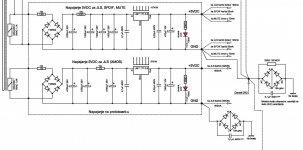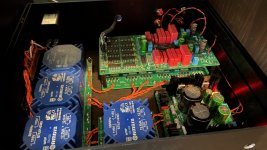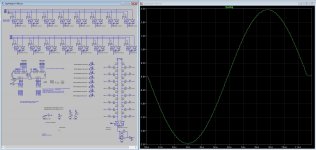Agree. The resistors is one of the big problems. Best option is still the old chips imho.Over the years I have seen many designs of Discrete R2R DACs, with claims that they sound better.
I have seen next to no performance measurements though.
The fundamental design of a discrete R2R DAC is well explained here :
http://www.sonicillusions.co.uk/discrete_dac.htm
And most of the problems of such designs are well known, including the need to use 0.01% resistors, etc. :
https://www.diyaudio.com/community/...-magnitude-24-bit-384-khz.259488/post-3999275
https://www.diyaudio.com/community/...-magnitude-24-bit-384-khz.259488/post-4004298
https://www.diyaudio.com/community/...-magnitude-24-bit-384-khz.259488/post-4010487
So I very much look forward to you showing us something original and innovative, whenever you are ready to do so.
Cheers,
Patrick
That's exactly what I needed for a headphone preamp. I was thinking how to make such a circuit, and here is the finished solution. It will even work as a mute circuit when the preamp is turned on and off. Thank you Miro.Protection against DC offset voltage on DAC or Preamp output

I compared today JLsound Xmos and Amanero (Cetecj) on different tracks. It was Jesse Cook - Libre and Live Haggard - Awaking the Gods DVD.
Jlsound gives more "airly" sound with more open mid and high and Amanero gives drier and restrained sound. You can hear it clearly. That's why I told about studio and flat sound but with Jlsound transport the "more colors appears". I used same cables, I2S, etc. JLsound without power supply - I'm planning to buy (is there a reason?). I'am very happy with that Xmos
Photo of the audiophile debauchery
Jlsound gives more "airly" sound with more open mid and high and Amanero gives drier and restrained sound. You can hear it clearly. That's why I told about studio and flat sound but with Jlsound transport the "more colors appears". I used same cables, I2S, etc. JLsound without power supply - I'm planning to buy (is there a reason?). I'am very happy with that Xmos
Photo of the audiophile debauchery
Attachments
The biggest advantage of JLSound is that you can drive almost all R2R DACs direct without all the shift registers.
Much much simpler and direct. No logic in between.
Here an example of JLSound driving PCM1704 direct :
https://www.diyaudio.com/community/threads/any-project-with-pcm1704.325249/post-5810069
Patrick
Much much simpler and direct. No logic in between.
Here an example of JLSound driving PCM1704 direct :
https://www.diyaudio.com/community/threads/any-project-with-pcm1704.325249/post-5810069
Patrick
What kind PSU I need it?Usb supply is never good, so you will most definitely hear the difference with linear supply to it. Even with a quality smps with marks filter you will hear quite a difference.
I assume that high precision resistors are not needed for DC protection board.
I use this:What kind PSU I need it?
Attachments
If you have spare psu miro boards, you can use those. If not, you can use proto board and use schematic that nixie posted. You need two +5V for jlsounds board, one with ~400mA and one with ~100mA load, separate secondaries.What kind PSU I need it?
I can't buy. Only from ali or DIY.
I use PSU-1 by Miro.If you have spare psu miro boards, you can use those. If not, you can use proto board and use schematic that nixie posted. You need two +5V for jlsounds board, one with ~400mA and one with ~100mA load, separate secondaries.
I use that in Pavouk AD1865 DAC. For PCM63 I wil choose LT1963. In principle, just avoid the LM317T or 7805 of unknown origin, buy only originals. The LM1117T proved to sound good, and there are others. Ebay, Aliexpress, but primarily avoid kit form, look only for PCB and buy quality parts.
Over the years I have seen many designs of Discrete R2R DACs, with claims that they sound better.
I have seen next to no performance measurements though.
The fundamental design of a discrete R2R DAC is well explained here :
http://www.sonicillusions.co.uk/discrete_dac.htm
And most of the problems of such designs are well known, including the need to use 0.01% resistors, etc. :
https://www.diyaudio.com/community/...-magnitude-24-bit-384-khz.259488/post-3999275
https://www.diyaudio.com/community/...-magnitude-24-bit-384-khz.259488/post-4004298
https://www.diyaudio.com/community/...-magnitude-24-bit-384-khz.259488/post-4010487
So I very much look forward to you showing us something original and innovative, whenever you are ready to do so.
Not better than advanced designs, there are many very good
It can be improved in many ways. The only thing missing is time for that
Resistors can be 0.01% ... or existing DAC chip can be used instead of the most precise resistors and the most significant bits stays from R-2R (like 8-bit from resistors) (this is how D20400 is created).
Very accurate switches with low resistance can be used. It can handle the higher current better, like the TS5A4624 (only 1R on-state resistance). Plus a clean power supply and it will be even better separated from the digital interference.
SignMagnitude is interesting concept. One CPLD can do the job, but I like digital logic circuits and I created signMagnitude concept from that logic
Maybe sometime in the future I'll do something better
Attachments
- Home
- Source & Line
- Digital Line Level
- DAC AD1862: Almost THT, I2S input, NOS, R-2R




